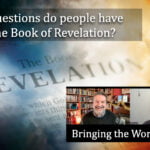I have written a chapter for a book coming out next year offering a faithful reading of Revelation but engaging with the critical (in both senses of that term) questions around this book. My chapter is on the genre of Revelation—what kind of writing is it? In the first half of the chapter, posted here, I explored why this question matters, and what we can say with confidence about Revelation’s genre. In this second half, I explore the complexities around the issue in this remarkable text and offer a reflection on way that Revelation relates to the world it describes. Please note that this is a pre-publication draft text.
To the threefold complexity of genre outlined previously—Revelation as letter, as prophecy, and as apocalyptic—we must add three further observations in order fully to reflect the nature of the text of Revelation.
Changes in Genre
First, it is hard to avoid noticing the rapid and disorientating changes of micro-genre in the first chapter of the book.
| Verse | Text | Genre |
| 1 | The revelation of Jesus Christ… | Apocalyptic |
| 3 | Blessed is the one who reads aloud the words of this prophecy… | Benediction |
| 4 | John, to the seven churches in the province of Asia… | Epistle |
| 5–6 | To him who loves us and has freed us from our sins … be glory and power for ever and ever! Amen | Doxology |
| 7 | Look, he is coming with the clouds…! | Apocalyptic |
| 8 | “I am the Alpha and the Omega,” says the Lord God | Prophecy |
| 9 | I, John, your brother and companion… | Epistle |
In addition to the apocalyptic, epistolary and prophetic that we have already noted, John makes use of two further genres, and switches rapidly between all five in successive sentences. This has the effect of making the hearer or listener wonder exactly what this text is, and so makes this a highly engaging and involving text for the reader or hearer.1 It also communicates that this text is not quite like anything we have read before. And this effect continues throughout, though not quite as intensely as in these opening verses, so that in the middle of a vision we might get an interjection of praise (16:5–7) or at times it might seem that John is stepping out of “vision report” mode and adding his own response alongside his audience (Rev 18:14 and 20).
The addition of “benediction” or blessing is effected by the sevenfold repetition of makarios (Rev 1:3, 14:13, 16:15, 19:9, 20:6, 22:7, 22:14) which is associated both with keeping the faith and with “keeping” the words of “this prophecy.” It reflects similar uses in the LXX of the Psalms, including the programmatic use in Ps 1, and echoes the makarisms of the Beatitudes in Matthew 5. In all cases, there is an implied “divine passive,” where it is God who blesses the faithful keeper.
Hymnic Material—praise, court ceremonial, and magic
Secondly, the presence of doxology, or praise, points to a fourth major genre, and as this has been explored extensively in studies of Revelation, it is rather surprising that this does not feature in discussion of Revelation’s genre.
The Book of Revelation is, quite literally, hymn-laden. Fifteen hymns or hymn fragments are commonly recognized (Rev 4:8; 4:9–11; 5:9–10; 5:12; 5:13; 7:10; 7:11–12; 11:15; 11:16–18; 12:10–12; 15:2–4; 16:5–7; 19:1–4; 19:5; 19:6–8), and some scholars have identified even more.2
To these, Elizabeth Schüssler Fiorenza adds 1:6, our opening doxology, Rev 13:4, the praise of the beast, and Rev 18:1–24, the three sets of woes lamented by the kings of the earth, the merchants, and the sea captains.3 Other associated material is formatted as poetic or hymnic in many modern English translations.
Within the hymnic material, two major influences can be seen. Alan Garrow has not been alone in suggesting that the hymns and songs reflect actual worship practice in the early Jesus communities, though his argument about the way they structure the text has not gained support.4 We might simply note the pervasive Old Testament allusions in the hymnic and doxological material: Ex 19:6 in Rev 1:6 and 5:10; Dan 7:13 and Zech 12:10 in Rev 1:7; the Trisagion of Is 6:3 in Rev 4:8; the adaptation of Gen 10:31 in the four-fold phrase of Rev 5:9; Is 49:10 and 25:8 in Rev 7:16–17; Ps 2:1 and 5 in Rev 11:18; and so on. Added to that we find Hebrew terms transliterated and Aramaic terms implied in the Greek text in the form of “Amen” (eight times), the injunction “Come, Lord Jesus” which corresponds to the Aramaic term “maranatha” (1 Cor 16:22), and the transliteration “allelouïa” (four times). Given that Revelation is the only place in the New Testament where this last transliteration occurs, we must credit this book with the importing of the term into Christian worship.
The second major influence is the Roman imperial court ceremonial (“emperor worship”) as demonstrated by David Aune.5 He notes the correspondence of particular aspects of the worship scenes, especially in Rev 4–5, with the Roman court and obeisance to the emperor, including the 24 elders, their white apparel, prostration, the casting of gold crowns, the repetition of chorus phrases, and the reference to God being “worthy.”6 But he also sees broader correspondences with the claims of the emperor, including a majestic passivity, the emphasis on justice, and the claim of the consensus omnium.
John’s depiction of the ceremonial in the heavenly throne room has been significantly influenced in its conceptualization by popular images of Roman imperial court ceremonial. …[T]he constituents…have been heightened, expanded, and given even greater cosmic significance. The result is that the sovereignty of God and the Lamb have been elevated so far above all pretensions and claims of earthly rulers that the latter, upon comparison, become only pale, even diabolical, imitations of the transcendent majesty of the King of kings and Lord of lords.7
Alongside this, we also find some elements of Graeco-Roman magic, including the phrases “I am coming quickly” (Rev 3:11, 22:7, 22:12, 22:20), “I have the keys to death and Hades” (Rev 1:18) and “I am the Alpha and the O.”8 Although these are not part of the hymnic material, they are closely related to it, and the phrase “Alpha and Omega” occurs only in Revelation and has become pervasive in Christian songs and hymnody.
This points to the impact of the hymnic genre on the reading of the text. In modern contexts, reading these parts, especially when they include “Amen” and “Alleluia,” encourages the audience to participate—it is hard to keep them silent! The same was surely true of reading in the first, congregational, context (Rev 1:3).
Music plays a larger role in the book of Revelation than in any other book of the New Testament, and few books in all of Scripture have spawned more hymns sung in Christian worship today.9
Numerology
Our final addition to the complex, intergeneric, hybrid form of the text10 arises from one of the four ways that John makes use of numerology and numerical composition:11 the occurrence of key terms with special frequencies. So we find that there are seven blessings, seven “sickles” in Rev 14, seven times God is titled “Lord God Almighty,” seven occurrences of “Christ,” “testimony of Jesus,” “prophecy,” “I am coming,” “sign,” “endurance,” “cloud,” seven mentions of the elders and living creatures together (each combination being grammatically unique) and seven occurrences of the fourfold phrase “every tribe, language, people and nation” and its variants. Jesus, the Spirit and the “holy ones” are all mentioned 14 times, significant as 2 x 7, where two is the number of reliable witness according to Deut. 17:6, so all three are connected with “faithful witness.”12
What this means is that the genre of Revelation must take into account not only issues around literary structure, semantic content, referential force, and metaphor, language and vocabulary, but the very form and shape of the text as it is written on papyrus. To borrow the language of Larry Hurtado, the written text of Revelation is in itself an important artefact13 or, as Andrew Ollerton puts it, we need to take seriously its “material form.”14 It is not merely the sound, content or referent of the words in the text that are bearers of meaning, but the very arrangement of the letters on the page.
Conclusion
To return to our opening question: What kind of text is the Book of Revelation? The answer is complex, because John appears to have quite self-consciously combined multiple genres and kinds of writing in the Book of Revelation.15 The text certainly appears to resist the imposition of established categories and expectations.
The Apocalypse gives the reader the opportunity to focus on one or a combination of several alternatives, but whatever boundaries the reader places around it cannot bind the text. It will not stay in bounds. It is constantly breaking out of its frame…Thus, this book is both a bane and blessing to interpreters. It provides simultaneous frustration and pleasure to the reader.16
Why might this be? In part, because the speech of God, to which John is testifying, can never simply fit into categories of human speech, even if human speech is the chosen vehicle for divine speech. This is true of all of Scripture, and in some sense parallels the mystery of the incarnation. People who met Jesus were both drawn to and puzzled by what he said and did, so in the gospels we see the repeated refrain “Who can this be…?” In a similar way, our encounter with Scripture will often leave us both enriched and challenged, both blessed and baffled, and especially so with the Book of Revelation.
But if John is here consciously writing this text17 as a closure of the canon of Scripture,18 as suggested by his incorporation of a vast number of allusions to the Old Testament, then we might expect the genre of Revelation to, at one level, reflect all the generic diversity of the Scriptures that have preceded it.19
And perhaps John has written a text which actually reflects the world he is living in, understood theologically, and the call to faithful discipleship he is urging—perhaps this text embodies the very thing it is talking about. We might say that it is self-referential, or even that it has a “fractal” relationship with the world; it represents, in nuce, the world it is describing. If, as Linton says, Revelation “provides simultaneous frustration and pleasure to the reader,” this is because it is depicting a world in which, as faithful witnesses to Jesus, we experience simultaneous suffering and kingdom (Rev 1:9). And just as John calls us to “patient endurance” to live in this world, we also need “patient endurance” to hear, understand, and read well this remarkable and life-giving text.
Footnotes
- This makes Revelation what Roland Barthes described as a highly “writerly” (as opposed to “readerly”) text which demands active involvement of the reader in the process of interpretation, or what Umberto Eco calls an “open” rather than “closed” text. See the discussion in Gregory Linton, “Reading the Apocalypse,” 24–25. This is rather surprising, as it contradicts the widespread assumption that Revelation is a “dictatorial” text which is highly determinative.
- Robert S. Smith, “Songs of the Seer: The Purpose of Revelation’s Hymns,” Themelios 43.2 (2018): 193–204. Smith offers an extensive list of studies of Revelation’s hymns within the notes.
- Elizabeth Schüssler Fiorenza, The Book of Revelation (Minneapolis: Fortress, 1985), 164.
- Alan Garrow, Revelation (London: Routledge, 1997), 34–35.
- “The Influence of Roman imperial court ceremonial on the Apocalypse of John,” originally in Biblical Research 18 (1983): 5–26, now included in Apocalypticism, Prophecy, and Magic in Early Christianity (Grand Rapids: Baker, 2008), 99–119.
- Robert Smith, ibid, separates “source” from “function” of the hymnic material, and puts OT influences in the first category and imperial court influences in the second. I don’t think that is true; the imperial court has shaped the form of the hymns, not just their function. It is thus somewhat ironic that, through Revelation’s influence down the centuries, Christian worship has unwittingly been shaped by the cult of the emperor!
- Aune, “Roman Imperial court ceremonial” p 119.
- David Aune, “The Apocalypse of John and Graeco-Roman revelatory magic,” in Aune Apocalypticism, 347–367. In the text of Revelation, “alpha” is spelt out, but the omega is not, being designated simply by the single letter.
- Craig R. Koester, “The Distant Triumph Song: Music and the Book of Revelation,” Word and World (Luther Seminary) 12.3 (1992): 243.
- Terms used by Linton, “Reading the Apocalypse,” 23.
- For an account of the four aspects of numerology and numerical composition (the use of actual numbers in the text, the geometry of square, rectangular, and triangular numbers, gematria, and word frequencies, see Paul, Revelation, 34–39.
- See “Structure and composition,” in Bauckham, Climax of Prophecy, 1–37. For a fuller list, and the significance of these for compositional theories, see Paul, “Source, structure and composition” pp 41–54 in Garrick Allen, Ian Paul and Simon Woodman (eds), The Book of Revelation. Tübingen: Mohr Siebeck, 2015.
- Hurtado, The Earliest Christian Artifacts (Grand Rapids: Eerdmans, 2006).
- Ollerton, A Theology of the Bible (Cambridge: Grove Books, 2021), chapter 2.
- There is an interesting modern parallel in the example of Ulysses by James Joyce, a famously difficult text because of its radical stylistic variations. When subjected to early stylometric analysis by A Q Morton, Morton concluded that it was written by five different authors—none of whom was James Joyce! A. Q. Morton, Literary Detection: How to Prove Authorship and Fraud in Literature and Documents (New York: Scribner’s, 1978). For a full discussion, see Tim Hiatt, “Stylistic Variations in James Joyce’s Works,” Deseret Language and Linguistic Society Symposium Volume 19.1 (1993): article 17.
- Linton, “Reading the Apocalypse,” 40–41.
- “It is not too much to say that the author of the Apocalypse, despite his idiosyncratic grammar and style, may be the most textually self-conscious Christian writer of the early period.” Harry Gamble, Books and Readers in the Early Church (New Haven: Yale UP, 1995), 104.
- As suggested by Külli Toniste, The Ending of the Canon, LNTS (London: Bloomsbury, 2016).
- For a summary of the extensive use of the OT in Revelation, see Ian Paul “The Use of the Old Testament in Rev 12,” in The Old Testament in the New Testament, ed. Steve Moyise (Sheffield: Sheffield Academic Press, 2000).





























I love that James Joyce parallel- a cautionary note to all critical scholars!?
Prophecy: without defining it, are there not two main aspects 1) forth -telling, speaking to the here and now, in context of the (then) present and 2) fore -telling, speaking of the future, what is yet to come, bearing in mind that God is outside of time, in his Omnipresence, Omnipotence, Omniscience over the created material world.
It’s a wonder, it seems to me, that it has not been categorized as myth or magic realism (as opposed to Greco-Roman — pagan- pluralism- magic.) Perhaps as “true myth” as meant by CS Lewis?
Thanks.
Hi Ian, I was wondering if you could expand the comments on the links between certain phrases and magic. This isn’t something I’ve come across before.